Zangling in Warwickshire
Snap-Happy
It was suggested in the angling press recently that the record zander should have been dubbed ‘The Traveller’ and I have to agree. Zeds are natural tourists and Warwickshire is fast becoming their Costa Brava. In this heritage-soaked county there are few rivers and canals that have not been visited and eventually settled by excitable, wide-eyed and organised groups of pikeperch ‘snapping up’ local culture.
I want to be specific here. If you mention Warwickshire and zander in the same sentence to your average predator fanatic, the chances are that he or she will start drooling over the prospect of big fish venues such as Coombe Abbey or mythical ‘banker’ stretches of the river ‘below Stratford’.
Well, if the truth be told, Coombe is technically in the West Midlands and most of the monster-chasing circus ply their trade across the border in Worcestershire nearer to the Avon’s big sister, the Severn. In this ramble through Shakespeare country, I shall focus on the ‘Warwickshire’ Warwickshire Avon as it flows south from the confluence with the Leam at Warwick towards Stratford. You are incredibly unlikely to appear on any BRFC list as a result of reading this article but I hope to convince you that the Bard’s river presents your average zangler with many opportunities for pioneering spiky sport.
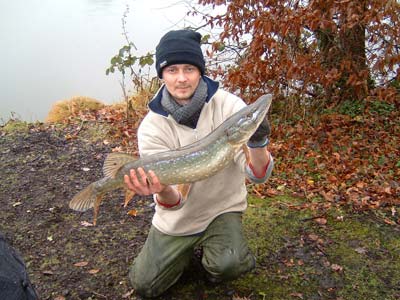

Autumn At Coombe Abbey: Not A Record, Not In Warwickshire, Not A Zander
Zander! Shhhhhh.
Avon zanglers are legendary for their cabalistic secrecy. Unfortunately zander, like package tourists, carry an excess of baggage. Those noble dorsal spines and alien eyes that we admire so much are, for some of our fellow fisher-folk, the fashion equivalent of a Hawaiian shirt and Union Jack boxers. Zeds are alleged to be ruthlessly efficient at throwing their towels into the best silverfish swims and have developed an unfounded reputation for mob-handed rowdiness and casual violence. Sadly this view is held by a sizeable minority of fishermen on the Avon and in many cases this antipathy extends to pike as well. I have lost count of the times I have found myself being told in no uncertain terms that all predators should be hung up from the nearest tree.
All these factors conspire to make Warwickshire pred-heads a furtive bunch especially when it comes to discussing our intended quarry with fellow anglers. I am fully aware of the irony when I get approving nods when my muttered reply is ‘carp’ or ‘barbel’. On the day that I shot the pictures and fished for this article I came across a very sorry but not necessarily rare sight. I won’t name and shame the club stretch that I found this poor little chap on, but it was the morning after a regular Sunday match and this was the scene on peg 12 (see below). So once you find the fish please keep it quiet!
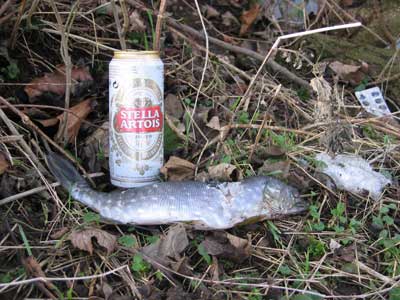

A Very Sorry Sight
Location, Location, Location
But let’s not get too downhearted. Despite their bad press, a series of unsuccessful electro-fishing campaigns and the occasional fatality when a Z blunders into the ‘wrong’ match or pleasure session, zander have survived and thrived in Warwickshire.
If any obstacles had remained to their progress then the massive floods of 1998 must surely have changed that. Since that soggy April even the diminutive Leam throws up the odd tiddler well above the high town weir. Most fishing between Stratford and Warwick is available for the cost of a day ticket or reasonably priced club book. I have not explored all the water available yet so I cannot guarantee you will find fish along the whole stretch but there are plenty of good starting points in the form of features.
Bridges, canal viaducts, weirs and long deep breamy-looking sections are plentiful and all worth a go. Along these stretches you will struggle to find another zangler on the bank yet the fish are there for the pioneering fanatic and when conditions and location come together the sport can come thick and fast. It can get pretty busy on weekends particularly around Warwick and Stratford where regular weekly matches are held. It is naturally a good tactic to pop into a local tackle shop and enquire which pegs are the hot ones to draw. To be honest though, nothing beats walking the bank and you will find that some swims are more obvious than others.
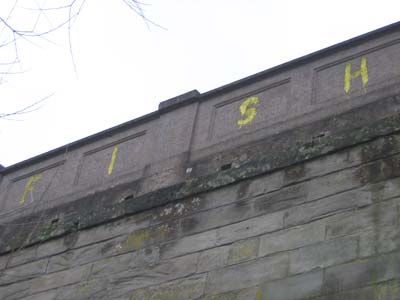

A Good Place To Start?
Potential?
And so to the crucial question, what stamp of fish can you expect to find? Well the average size of the zander is not huge at 4-5lb, but you can realistically expect semi-specimens in the 6-8lb class to top your catch. There is an outside chance of the odd ‘lurking’ double but it has to be said that the larger fish are by no means easy to locate. They are thin on the ground, tend to be far more nocturnal than their schoolie mates and appear in the unlikeliest places. If you are after your first double I’d try elsewhere. That said, I took a friend out for his first ever zangling session last winter and despite arriving on the bank (fashionably late) at 10 in the morning, his first cast produced a venue record beast of 9lb 4oz so the potential is there.
If you are unlucky enough to receive the attentions of ‘nuisance’ fish (what a daft expression!) then pike do reach sporting low to mid doubles, but most are ‘pea-in-a-pod’ jacks. I have also had the odd eel to 2lb whilst legering tiny deads.
Contrary to conventional zander wisdom on the stretches I have explored so far there are multiple catches to be had in daylight. As a general rule of thumb I would suggest you have a cup-a-soup or similar light refreshment ready for the 12-2pm lunchtime quiet zone. Don’t get too relaxed though because the pike will bite all day. Fishing into the night or through dawn is still the best path to consistent catch rates but there is hope there for you slugger-beds too!
Tackle Out! It’s the Techno-Ramble
Most of my zangling involves the use of deadbaits or lures. The main reason for this is that I am a terrible silverfish angler so livebaiting is not a viable option. If I am confident on location I favour a static approach legering mini-deads (roach or bleak) on two rods, one hard on the bottom and one popped up. Terminal tackle is simple. I used to be obsessed with tiny hooks (10/ 12) but I have been experimenting recently with larger sizes. The bigger hooks do look a bit odd on 3-5″ baits but provided the trebles are correctly spaced (to prevent deep hooking) they work a treat. My standard snap now consists of a pair of size 6 or 8 semi-barbed trebles mounted on 14-16″ of old-fashioned ‘cheap-as-chips’ 20lb Drennan Seven Strand. Above this runs a 2-3oz bomb on a long weak link tied to a John Roberts leger ring.
The heaviest rod I use on the river is a 2lb tc but for most legering situations I favour my 1.25lb tc John ‘The Giggler’ Wilson Avons. The Avon is for the most part a placid river with a nice even flow and using such a sensitive rod means that the tiniest nibble is transmitted straight to the tip.
Enterprise isotope holders help exaggerate any movement. Until recently my favoured mainline was 12lb Fox Warrior mono but I am now a convert to the many advantages of braid and particularly Power Pro. I use front alarms with droppers but the tip is inevitably the front line of bite detection whilst zangling at short range, and if it quivers hit it!
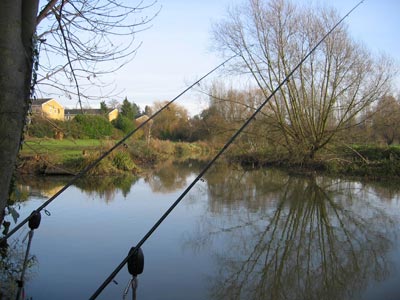

Waiting It Out In Shakespeare Country
Fish-mobility.
If I am out and about and trying to find the fish I will search as many swims as possible and I achieve this with a combination of float-legering and long-trotting. Float-legering is a brilliant method for exploring tight swims whilst out on the rove. With a bit of trial and error (that tungsten putty stuff is good) it is possible to achieve incredibly sensitive presentation when the river is running at its usual sluggish pace. Long-trotting comes into its own on the many slow straight breamy sections where a bait can be teased along and held back in likely looking Z haunts. Both methods use essentially the same kit but if I’m long trotting I will clip on an uptrace and reverse the bait on the trace so that on the retrieve it swims tantalisingly in a corkscrew motion.
Spinning can be a particularly enjoyable method on the Avon and is a great way of locating feeding fish. I have had a lot of success with those squidgey lures from Storm particularly the small shads and also (appropriately) Shakespeare’s Devil’s Own Soft Tails.
Lure fishing can be expensive though unless you have strong braid on your reel. The river is not known for its pace or power and is rarely properly flushed by floods and for that reason it has more than its fair share of enormous snags. Mind you on the plus side, spinning with strong tackle is a great way to work out where not to cast, and snags, particularly those near man-made structures, often mean pikeperch!
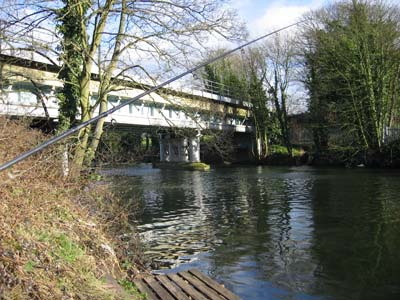

Structure Is Often The Key To Location, But Not Today!
A Few Words of Warning and Encouragement.
I am hoping by this point that you may have read enough to whet your appetite. As I stated earlier my own exploration of this part of the Avon is still in its infancy but the results so far have been more than encouraging.
There are a couple of pitfalls and hazards that you should be aware of though before you start. Because of its position at the heart of English heritage land, fishing on Ye Olde Avon is seasonally influenced by the mass migration of tourists. Despite the fact that this part of the river is non-navigable for much of the year the waters around Warwick and Stratford are awash with camera-toting would-be admirals in deadly pedaloes and boats.
This is certainly a factor that the late spring/ early autumn zangler should consider before parting with cash for a day ticket. Choose your cast wisely on these busy stretches, as each craft is equipped with some kind of high-tech sonar that can pick out the trajectory of a line with unerring accuracy. I do most of my predator fishing between November and March but even the icy depths of winter have not provided absolute protection. I had both rods wiped out in the biting cold and total darkness of a December night session by a mysteriously silent nocturnal oarsman.
Please check the rules in club books before you buy. Leamington Angling Association regulations, for example, prohibit the use of any coarse fish baits, live or dead. So it’s out with the lure rods or maybe a bit of exotic deadbait experimentation? Have you ever tried herring/ mackerel tails or wobbling smelt?
The next time you get dragged on a trip to Warwick Castle or Shakespeare’s birthplace, pop your rods in the car boot, sneak off to the river and have a crack at some real zangling culture.













